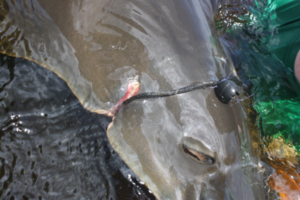Sawfish Need a Hand from Anglers, Boaters and Waterfront Homeowners
by Tonya Wiley, Havenworth Coastal Conservation
from The Fishing Wire

Tangled Sawtooth needs help
Entanglement of marine species in lines, fishing gear, and other debris is a problem seen with unfortunate regularity in the southeastern United States. This includes Endangered Species Act-listed species such as North Atlantic right whales, giant manta rays, sturgeon, turtles, and smalltooth sawfish. Each species is susceptible to entanglement based on their physical attributes but none more so than sawfish.
The toothed rostrum of the smalltooth sawfish could be considered one of the most unique morphological traits in any species. Yet this feature has also directly led to the species’ decline. Sawfish are rays that generally swim along the sediment surface where marine debris can accumulate. The toothy rostrum is easily entangled in any debris the sawfish encounters, which can lead to injury, deformation, or death by suffocation or starvation. Sawfish entangled in a variety of man-made items including dock lines, trap lines, nets (gill nets, cast nets, trawls, etc.), fishing lines, pvc pipes, coffee cans, dog toys, and elastic bands have been reported. While strides have been made in recent years to raise awareness about sawfish entanglement, this threat continues to affect the species.
Historically, a number of commercial fisheries incidentally captured smalltooth sawfish in the southeastern United States, though none more prominent than inshore gillnet fisheries. Because juvenile sawfish rely on shallow inshore waters as nursery habitat, gillnet fisheries for mullet in these same areas resulted in extensive incidental capture of sawfish. Once entangled, the toothed rostrum was difficult to remove from nets so often these fish were simply killed as bycatch. The 1995 gillnet ban in the state waters of Florida has been instrumental in reducing the number of sawfish killed by this gear. However, illegal use of gillnets still results in mortality of sawfish.
Recently two sawfish entanglements have been highlighted on social media. In late 2018, the National Park Service reported a sawfish entanglement in Biscayne Bay National Park (see https://www.fisheries.noaa.gov/feature-story/saving-endangered-sawfish). In this instance a sawfish was trailing lines from a lobster pot. Excessive entanglement can affect mobility, feeding, and thus overall fitness. If unattended, these entangled animals are likely to perish. Fortunately, park rangers were able to secure the lines, and remove them from the sawfish.
In a separate event, the National Park Service responded to a tip that an illegal gillnet was found in the waters of Everglades National Park near Chokoloskee, Florida. Upon retrieval of the net, law enforcement discovered a dead sawfish. This example illustrates just how deadly these nets can be to this endangered species. Law enforcement is still investigating this case and has requested that anyone with information to please contact 305-242-7741.
It is a shared responsibility of all outdoor enthusiasts to keep our waters free of trash and debris, which could result in entanglement. Next time you’re out on the water, do your part to pick up any trash or debris and if you ever encounter a sawfish please let us know by calling 1-844-4SAWFISH.
Tonya Wiley, President
Tonya@havenworth.org
941-201-2685
www.havenworth.org
Tax-deductible donations to help us continue our mission to promote the sustainable use and conservation of marine resources through research, outreach, and education can be made at https://www.oceanfdn.org/donate/havenworth-coastal-conservation